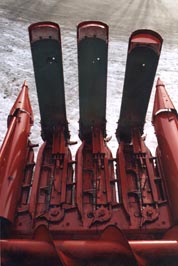
If you've ever considered switching to narrow row corn you'll want to take a close look at this 15-in. row header built by Don Morse of Birch Run, Mich.
His 15-in., 11-row header is a copy of a prototype header designed by Alpha, Ill., farmer-researcher Marion Calmer. It has only one gathering chain per row and an ear guide on the opposing side.
Morse took two International 863 heads, stripped them down, picked out the best frame, and started rebuilding. Gear boxes had to be milled and the framework that the stripper plates and gathering chains run on had to be cut down with a plasma cutter.
Snout
covers were made out of 10-in. pvc pipe cut lengthwise in half. The snouts are
the tips from the original header. Morse says the total weight of the 11-row
header is close to the weight of a typical 8-row unit.
According to Morse, Case-IH and Deere are both looking at Calmer's 15-in. cornhead design. Once the narrow head becomes commonplace, Morse says he expects that farmers will quickly convert to 15-in. rows.
Planting soybeans in narrow rows using a no-till planter originally got him started thinking about narrow rows, Morse says. The appeal of increasing corn yields with little additional cost, except for seed, made him look at putting corn in narrow rows, too. "I finally came to the conclusion that if we could increase yields at no real extra cost, it just seemed like a natural thing to do," he says.
Morse traded a 2-year-old, 12-row front fold planter in on a factory-built, semi-mounted Case-IH 800 toolbar planter. The planter had factory-built splitter units that can be hinged up or down to plant 30 or 15-in. rows. For peace of mind, as Morse puts it, he leaves the units behind the tractor tire up, making tramlines that allow for herbicide application if needed, and for sidedressing 28% nitrogen.
Although coulter penetration wasn't a problem in narrow row no-till, trash flow was, says Morse. To get around residue flow problems, he extended the staggered splitter units from just 6 in. to 20 in. He set his population at 30,000 but is considering bumping it to 33,000 to 34,000. He broad-casts all of his fertilizer and puts all of his nitrogen down in the form of 28% with herbicide. This year, however, he plans to reduce the amount of 28% that he puts on with the herbicide, and then nitrate test at sidedress time and coulter inject what's needed based on test results. "I think I'd realize a dollar savings and not look at any yield loss," says Morse.
He also speculates that 15-in. rows provide an ideal environment in soybeans to reduce the incidence of white mold. "Fifteen-inch rows are supposed to be the thresh-old for optimum soybean yields, and you're also affording yourself some air flow, compared to drilled beans," he says.
